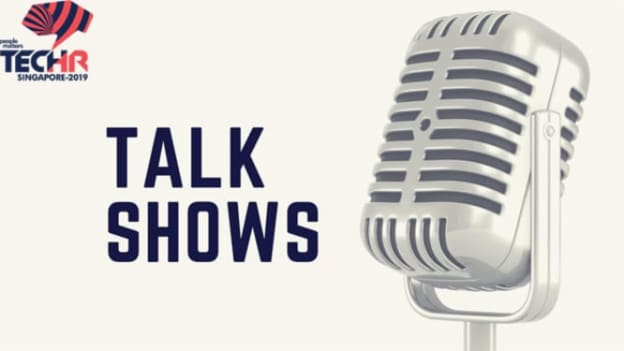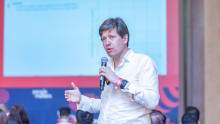Skilling the workforce from industry 3.0 to 4.0

TechHR Singapore 2019 Read similar articles

An insightful and interesting Talk Show on “Skilling your Workforce from 3.0 to 4.0” brought together some great industry practitioners at People Matters TechHR Singapore 2019. Moderated by Ryan Ross, the Managing Partner of Hogan Assessment Systems, the panel discussion brought out hard questions related to skilling which all organizations are grappling with in today’s world. Joining him were Ashley Chiampo - Senior Director of Learning, Chairman of Examination Board (EMERITUS), Dr. Gog Soon Joo - Chief Futurist, Chief Research Officer (SkillsFuture Singapore),Michael Jenkins - CEO, (The Human Capital Leadership Institute) and Nishchae Suri - President, India, SEA & Middle East (EdCast).
Workforce 4.0 is a label that people are trying to associate with the current workforce. Marked by extreme dynamism and volatility, this label is bringing in manifold changes in employee-employer relations and expectations.
The fusion of technology between physical, digital and biological is creating varying expectations on the ability of skills and knowledge required in the entire ecosystem. Hence, leaders must plan their learning and development strategies in advance to build a roadmap on up-skilling and re-skilling their current workforce.
Now, the question arises on ‘How to adopt workforce 4.0 while still dealing with workforce 3.0?’
In this volatile and ever-changing business world, corporations are tending to face a widening gap between the skills they need and the expertise available in the existing workforce. In congruence to this age, agility and ambidexterity are being seen as the two much needed future skills for leaders. When it comes to balancing the contradictory things happening around in organizations while adopting workforce 4.0 and dealing with workforce 3.0 at the same time, here are the two most important elements to be considered from an organizational perspective:
Toxicity
Regular learners cannot learn in a toxic environment. Parachuting a digital leader straight in a traditional set up may end up in a lot of conundrum thereby giving rise to the question of clean up. And a dysfunctional relationship with superiors adds to such woes. Hence, cleanup has to happen in organizations and leaders must be able to identify such early warning signals. One of the indicators is when managers make a distinction between work and learning, and learning needs get unnoticed. Repair the damage before it’s too late.
Learning mindset
This refers to the ability to take learning from a feeling of a chore to a moment of delight. It is imperative for HR leaders to help in bringing a change in the perception of learning. The concept of ‘learn – relearn – unlearn’ needs to be built upon as a core value in an organization to imbibe a learning mindset in the organization. This is one of the major tasks to be taken into consideration for adopting the new phase of 4.0.
After taking toxicity and learning mindset in consideration, an understanding of the starting and accelerating points of the skilling journey is equally critical.
How are companies addressing the skill gap
The companies that are able to strike the right skill balance for their workforce will always be at a strong advantage when it comes to skill gap reduction. A growing number of forward-thinking organizations are using tech and a blended approach to address the skill gap issue. Many companies are using appreciative enquiry approaches and engaging neurosciences technique to get to the core of it. However, an unprecedented skills crisis haunts them as corporations face a widening gap between the skills they need and the expertise available in the existing workforce.
A multipronged approach through various interventions will only help in addressing the looming skills gap issue with consistent effort in the coming years. To sum up, the three to one formula need to be exercised to up-skill the workforce when it comes to addressing the skills gap issue - ‘Use Tech to Scale, Speed and Sustain Learning’, ‘Make learning Accessible and Affordable’ and ‘Use Engagement as a tool to bring back a strong skill-will’ attitude for the current workforce.
Building a competitive workforce of the future requires right-skilling and organizations need to have a strategic plan for talent to make the shift. Based on this ideology, at Emeritus the learning testament is interwoven and their employees make every effort to up-skill themselves on their own, creating a better learning ecosystem.
Similarly, future credits are available with funding options for employees who individually want to upskill at SkillsFuture Singapore. However, companies need to plan much ahead for the skills they need and also start building it internally. Hence, the starting point of the skilling journey must be to make learning as the priority agenda.
Learning strategy needs to be aligned with organizational strategy as developing intrinsic need is more important than extrinsic need. For accelerating points of skilling journey, organizations must make the consequences of not learning evident and constantly reinforce its side effect.
Decode your learning culture in order to combat the disabilities of learning in an organization. One must use the four key elements of today’s new learning paradigm - Personalization, Contextualization, Democratization, and Consumerization.






